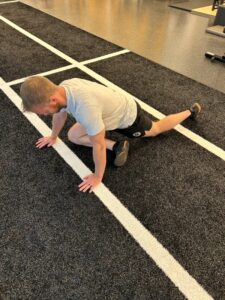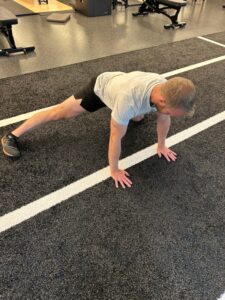Kevin Neeld: Maximizing Adaptation while Minimizing Recovery with Isometric Exercises
Throughout a season, athletes across all sports hit periods where maximizing performance and minimizing recovery times is essential. While maintaining a purposeful training presence is important for keeping an athlete ready to perform at their best, certain training methods create result in less fatigue/soreness than others, which reduces the performance drop, recovery timeline, and recovery resources resulting from training. Isometric exercises, which are characterized by creating force without any change in joint position, offer a strategy to deliver specific training adaptations while minimizing tissue damage/soreness. Here are three isometric training methods to consider:
1) Contract-Relax Mobility
Contract-relax mobility work involves getting into a position of stretch, holding this position for 5-10 seconds, then actively engaging the stretched muscle (without moving) for 5-10 seconds, then sinking deeper into the stretch, repeating for a specific number of reps or time.
There are two notable benefits of this strategy.
First, adding the contraction helps activate sensory receptors within the muscle that provide feedback on tension, and ultimately help to relax the muscle, allowing for increased range of motion.
Second, creating tension in deep stretch or “end-range” positions helps improve strength and control in these positions, which makes them more accessible in the future.
If the goal is simply to unlock more range of motion, athletes can perform 1-2 sets of 3-5 reps alternating a 5s stretch with a 5s contraction.
If the goal is actually add length to the tissue, longer duration holds are necessary. In this case, athletes can perform 2-3 sets of 6 reps alternating a 10s stretch with a 10s contraction.

2) Holding Isometrics
Holding or “yielding” isometrics require getting into a specific position and holding it for time. This strategy can be used for two primary purposes:
Short Duration Holds (~5-10s): Performing short duration holds with a heavy resistance is an effective strategy to develop strength in a specific range. As a general rule, strength transfers within +/- 10-15 degree range around a joint, so this method should be applied to develop strength around positions that are specific to a sport or at “sticking points” in a particular exercise.
Long Duration Holds (~30-120s+): Performing long duration holds with body weight or a low resistance is an effective strategy to improve range of motion and develop local muscular endurance. While the “mobility” work referenced above can help unlock range of motion, adding actual length to tissue (e.g. muscle) requires longer duration holds (>2 minutes).



3) Pushing Isometrics
Pushing isometrics are performed by pushing against an immovable resistance. Similar to the methods described above with Holding Isometrics, these can be performed with an intent to improve strength in a specific range (i.e. short duration holds) or to improve local muscular endurance (i.e. longer duration holds >30s).
Pushing isometrics can also be used to improve rate of force development (ROFD). Rate of force development describes how quickly force increases, and is a key factor in speed and power development.
This can be improved by maximizing the intended speed of movement, or in the case of pushing isometrics, by developing tension as quickly as possible. Even without movement, as is the case with isometric contractions, having an intent to move quickly recruits fast twitch muscle fibers earlier, which increases force faster.


Wrap-Up
Leaning on isometric exercises can be effective way to drive specific adaptations while minimizing tissue damage and the resulting recovery period. This is particularly beneficial for athletes in-season or anyone entering periods of high workload within their sport.

